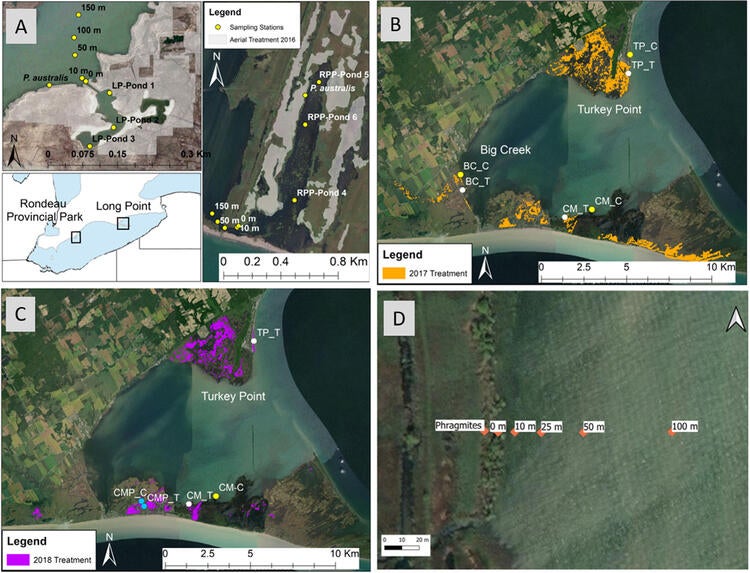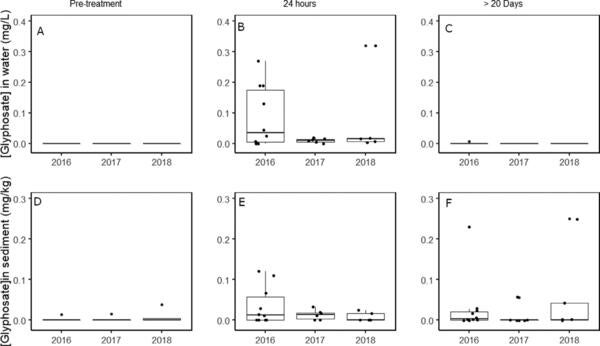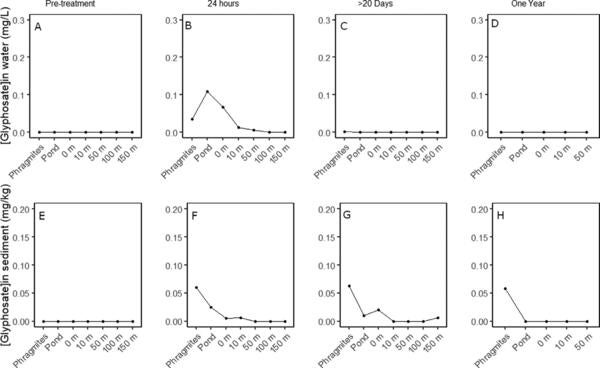Contact
 Courtney Robichaud, Department of Biology
Courtney Robichaud, Department of Biology
 Rebecca Rooney, Department of Biology
Rebecca Rooney, Department of Biology
Introduction
The invasive wetland grass Phragmites australis (P. australis) creates dense monocultures that negatively affect biodiversity, habitat quality and other ecological functions. During the 1990s, P. australis began to rapidly expand over marsh complexes on the north shore of Lake Erie, Ontario, Canada, home to a UNESCO Biosphere Reserve, a Ramsar wetland of international importance and essential habitat for migratory and marsh-nesting bird populations. To limit its extent and spread, the Ontario government conducted the first, large-scale application of glyphosate over standing water to control an invasive species in Canadian history with over 1,000 ha of marsh treated. The project used a special water-safe formulation of glyphosate called Roundup CustomTM that lacks surfactant, to which a water-safe alcohol ethoxylate surfactant called Aquasurf® was added.
The purpose of this study was to design and implement an extensive monitoring program to determine the after application maximum concentrations, dispersal and persistence of glyphosate, its primary breakdown product aminomethylphosphonic acid (AMPA) and the alcohol ethoxylate-based surfactant in water and sediment to identify whether there may be acute or chronic exposure concerns and whether year-over-year accumulation of residues could occur if follow-up treatments were implemented. The results address a key knowledge gap concerning the direct application of glyphosate over standing water to control an invasive wetland plant, a practice not currently legal in Canada outside of an emergency process.
Methodology
The pilot P. australis control project took place in three hemi- and emergent marsh complexes on the north shore of Lake Erie: Rondeau Provincial Park, Long Point and Turkey Point (Figure 1).

Figure 1: Control (C) and treatment (T) sampling stations in Long Point (LP) and Rondeau Provincial Park (RPP) (A), and in the Long Point region in 2017 (B), and 2018 (C). To assess dispersal from the point of application we established transects stretching from points of maximum exposure into the adjoining bay (example in panel D).
In 2016, 100 ha. and 355 ha. of marsh in Rondeau and Long Point respectively was treated with the herbicide mix applied from a helicopter. In 2017 and 2018, 329 ha and 100 ha respectively in the Long Point region were treated by ground application (Figure 1C).
In 2016, nine sampling stations in both Long Point and Rondeau Provincial Park were established. Three stations were placed in a semi-isolated pond surrounded by P. australis, and one in a patch of P. australis. Five stations were established along a transect stretching into Long Point or Rondeau Bay (Figure 1A). In 2016, water and sediment samples were collected at each station at three times: 1) pre-treatment, 2) within 24 hours of herbicide application, and 3) > 20-days after application.
In 2017, three pairs of transects were established into the Long Point Bay in three management units that were treated that year (Figure 1B). Each pair consisted of a ‘control’ and ‘treatment’ transect and consisted of six stations – the first within P. australis, then at 0 m, 10, 25, 50, and 100 m from the shoreline (Figure 1D). As in 2016, sampling occurred at pre-treatment, within 24 hours of herbicide application, and > 20-day time points. In 2018, two new stations and one new transect were established (Figure 1C) to monitor new treatment sites in Turkey Point and Crown Marsh. To evaluate the longer-term persistence of the herbicide mix, a subset of the 2016 stations were re-sampled in 2017 and 2018.
Outcomes
Concentrations of glyphosate and AMPA in water were highest within 24 hours of application, but remained below the established Canadian thresholds for the protection of aquatic life to short- (27 mg/L) or long-term (0.8 mg/L) glyphosate exposure (Figure 2B). Two application methods were used during the project, aerial and ground, with aerial application employing a higher loading rate of herbicide than ground application. The maximum concentrations of glyphosate in water detected after aerial application reflected this - there were more detections after aerial treatment which were on average higher than ground application, though the maximum concentrations were comparable. The concentrations of glyphosate in sediment followed the same pattern, with more detections that were on average higher within 24 hours of application, but similar maximum concentrations detected at the > 20-day timepoint (Figure 2F). These results indicate that one method does not lead to a significantly higher concentration of glyphosate or AMPA in the aquatic environment than the other.

Figure 2: Concentrations of glyphosate in water (A-C) and sediment (D-F) at sites with maximum exposure from treatment transects in Rondeau Provincial Park, Long Point, Big Creek National Wildlife Area, and Turkey Point, Ontario, Canada. Boxplots represent the median, the 25th (lower hinge) and 75th (upper hinge) percentiles, and lines extend to the largest value no further than 1.5 interquartile range from the 25th or 75th percentile.
Glyphosate and AMPA concentrations in water and sediment were highest closer to the point of herbicide application, but trace concentrations of glyphosate were detected in water and sediment over 100 m from a point of application. AMPA was not detected outside areas of maximum exposure. In terms of persistence, glyphosate and AMPA in water generally returned to pre-treatment concentrations (Figure 2A) by the > 20-day sampling timepoint (Figure 3C). Upon resampling in 2017 and 2018, no glyphosate or AMPA was detected in water samples (Figure 3D). In contrast, glyphosate concentrations in sediment were higher at the > 20-day timepoint (Figure 2F) and glyphosate was detectable in sediment up to one-year after treatment, though at lower concentrations.

Figure 3: Concentrations of glyphosate in water and sediment samples collected from Rondeau Provincial Park and Long Point, Ontario, Canada. Samples were collected before aerial-application of glyphosate-based herbicide, within 24 hours, > 20-days after, and one-year after application. Sites represent areas of maximum exposure to herbicide (P. australis, ponds, 0 m) and distance (m) out into the adjoining bay. The average concentration at each point is represented here.
AquasurfⓇ was not detected often enough in the water and sediment among the three years to provide robust insight into its dispersal or persistence in the system.
Conclusions
The negative impacts associated with applying glyphosate directly over standing water to control invasive wetland plants are not well known. Between 2016 and 2018, the Ontario government began an unprecedented management program in over 1000 ha of coastal marsh to control invasive P. australis. Despite extensive application of Roundup CustomTM with Aquasurf®, the research did not observe glyphosate or AMPA concentrations in exceedance of concentrations of concern for aquatic biota in water or sediment. Dispersal of analytes typically remained within 10 m from the point of application, though trace amounts of glyphosate were collected more than 50 m from the site of application in both sediment and water. Glyphosate concentrations persisted longer in sediment than water samples, and evidence indicates concentrations returned to pre-treatment levels at all stations after one year.
Based on this research, Roundup CustomTM appears to be a relatively safe and effective way to treat large scale P. australis invasions. However, other glyphosate-based herbicides may contain surfactants that dramatically increase the product’s toxicity. Moreover, repeated glyphosate applications can cause accumulation in sediment or wetland vegetation, where it can be released during decomposition. In addition to residue accumulation, there are several reported sublethal effects of glyphosate, including delaying periphytic colonization, reducing the abundance of diatoms and encouraging the development of cyanobacteria. Similar work in sensitive ecosystems should seek to assess the history of glyphosate application in the region and incorporate assessments of sub-lethal effects that may have unexpected biological consequences.
Robichaud, C.D. & Rooney, R.C. (2021). Low concentrations of glyphosate in water and sediment after direct over-water application to control an invasive aquatic plant. Water Research, 188. https://doi.org/10.1016/j.watres.2020.116573
For more information about WaterResearch, contact Julie Grant.







